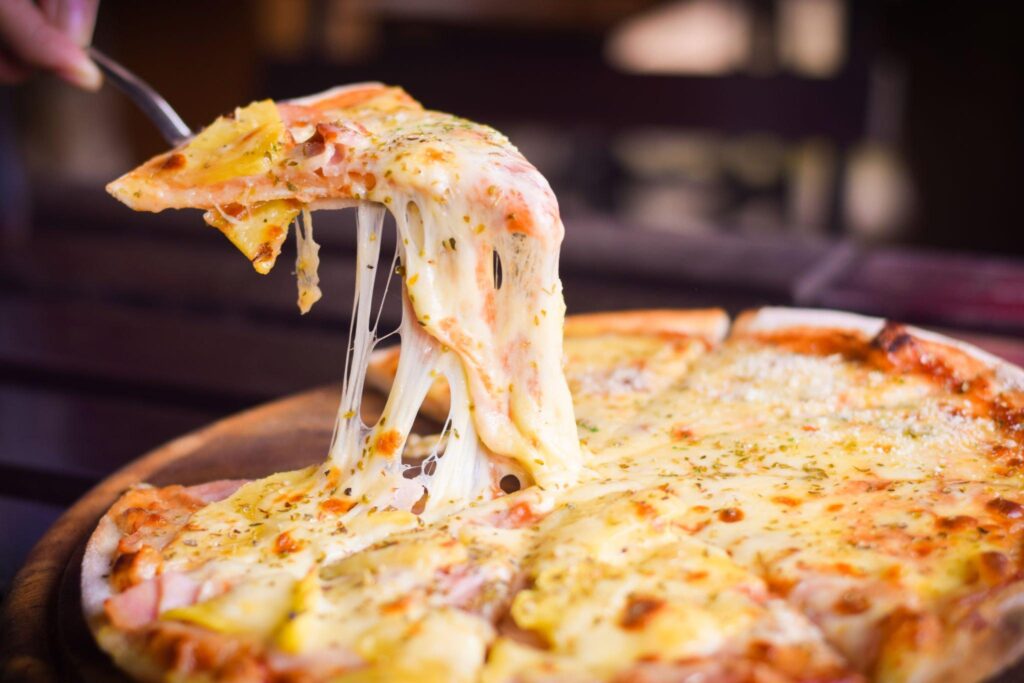Are you a big fan of pizza but worried about the calories it may contain? Pizza is one of America’s favorite foods, but it can be surprisingly high in calories, leaving many people wondering whether to indulge. While cheese pizza might seem like a relatively safe choice, there’s much more to consider regarding the actual calorie count. In this article, we’ll dive deep into the truth behind the calories in cheese pizza and explore some of the most popular pizza styles while providing helpful tips to make your slice healthier.
Explanation Of The Popularity Of Pizza
Pizza is undoubtedly one of the most popular foods worldwide, with almost every country having its own version of this classic dish. There are a few reasons why pizza is so popular:
- It is incredibly versatile. You can have a pizza with any toppings you desire, from classic pepperoni to more adventurous choices like pineapple and ham.
- It’s easy to make and even easier to order. With the rise of delivery services, getting a pizza delivered to your doorstep is just a few clicks away.
- It’s a food that people of all ages and backgrounds can enjoy.
- It’s just plain delicious.
The combination of melted cheese, savory sauce, and crispy crust creates a one-of-a-kind explosion of taste. No matter where you are in the world, chances are you’ll be able to find a pizza place nearby. Whether it’s eaten as a quick snack or as a full meal with friends and family, pizza will always be a staple in many people’s diets.
Importance Of Knowing The Calorie Count Of Pizza
It’s no secret that pizza is a fan favorite food for many people. Yet, with all of its tasty toppings and gooey cheese, pizza can also be packed with calories. That’s why it’s crucial to know the calorie count of pizza, especially if you want to maintain a healthy weight or improve overall health. By understanding each slice’s nutritional value and calorie count, you can make informed decisions about what to order or how many slices to eat. Additionally, knowing how many calories are in a whole pizza can help you moderate your portions and make healthier choices when ordering. It’s important to remember that while pizza may not be the healthiest food option, it can still be enjoyed in moderation. Balancing your pizza intake with healthy side dishes or vegetables can satisfy your pizza cravings without overindulging. So, make sure to do your research and know the calorie count of your favorite pizza options to make informed decisions about your diet and overall health.
How Many Calories Are In A Typical Cheese Pizza?
If you’re a pizza lover like many of us, you’re likely curious about how many calories are in a typical cheese pizza. According to the United States Department of Agriculture (USDA), one slice of cheese pizza weighing approximately 87 grams contains around 193 calories. However, the exact number can vary depending on the size and thickness of the slice, as well as the specific ingredients used. On average, a slice of cheese pizza contains around 250-300 calories, and a 14-inch large cheese pizza usually has eight slices, so that each slice would have around 125-150 calories. Of course, if you add toppings like meats or vegetables, the calorie count will be higher. It’s important to note that while a slice of cheese pizza may not be the healthiest option for a meal, it can still be enjoyed in moderation as part of a balanced diet. Eating just one or two slices and pairing it with a salad or other vegetable dish can make for a satisfying and relatively low-calorie meal. With a little bit of mindfulness and portion control, you can still enjoy the taste of cheese pizza without overindulging.
What Are The Nutritional Components Of Cheese Pizza?
Cheese pizza is a popular and delicious food. But have you ever stopped to consider its nutritional components? Here’s a breakdown of what you can expect:
1. Calories: A single slice of cheese pizza typically contains around 213-300 calories, depending on the size and thickness.
2. Fat: A slice of cheese pizza contains about 8-11 grams of fat. This is largely due to the cheese, which is high in fat and calories.
3. Carbohydrates: One slice of cheese pizza contains about 29-32 grams of carbohydrates. This includes 3-5 grams of sugar and 1-2 grams of fiber.
4. Protein: A slice of cheese pizza contains around 8-12 grams of protein.
5. Vitamins and minerals: Cheese pizza does provide some nutrients, such as calcium, vitamin B12, and vitamin C (from the tomato sauce).
It’s worth noting that the nutritional content of cheese pizza can vary depending on the specific recipe and ingredients used. For example, if the crust is made from whole wheat flour, it will provide more fiber and nutrients than a crust made from white flour. Additionally, if the pizza is loaded with vegetables, it will provide more vitamins and minerals.
While cheese pizza may not be the healthiest food option, it can still be enjoyed in moderation as part of a balanced diet. Pairing a slice with a salad or other vegetable dish can increase the overall nutritional value of the meal. Remember, the key is moderation and balance.
How Does The Method Of Preparation Affect The Calorie Count?
The preparation method plays a significant role in the calorie count of pizza. For instance, a deep-dish pizza will have more calories than a thin-crust pizza due to its larger volume and thicker crust. Pan-frying the pizza in oil will also add extra calories. On the other hand, baking or grilling the pizza lowers the calorie count by reducing the fat content. Furthermore, choosing whole wheat dough instead of traditional white flour crusts can significantly lower the calorie count. As for the toppings, using low-fat cheese instead of processed cheese or choosing lean proteins like grilled chicken and vegetables can reduce the calorie count. It’s also essential to avoid high-fat meats like sausage and pepperoni, which add many calories. Lastly, choosing light sauces like tomato or pesto instead of creamy sauces like Alfredo can help reduce calories. In conclusion, understanding how different cooking methods affect the calorie count of pizza can help make informed choices about what to eat and enjoy without compromising on taste.
Is All Cheese Pizza Created Equal In Terms Of Calories?
When it comes to pizza, it’s easy to assume that all cheese pizzas have the same number of calories. However, that’s not entirely true. The calorie count of cheese pizza can vary depending on various factors, such as the type of cheese used, the crust thickness, and even the preparation method. For instance, a slice of cheese pizza from Domino’s has fewer calories than a slice from Pizza Hut, even though both are made with cheese and similar crusts. It’s also worth noting that adding toppings like pepperoni or sausage will increase the calorie count significantly. So, while all cheese pizzas are not created equal in terms of calories, making healthier choices is still possible when ordering pizza. Opting for a thin crust, choosing vegetable toppings, and using low-fat cheese can all help reduce the calorie count of your pizza. Additionally, making pizza at home allows you to control the ingredients and create a healthier, more personalized pizza.
Other Types Of Pizza And Their Calorie Count
1. Neapolitan Pizza: Traditionally made with tomatoes and mozzarella cheese, a slice of an 8-inch Neapolitan cheese pizza contains around 230 calories.
2. New York-Style Pizza: With a thin crust that’s pliable enough to fold over easily, a slice of an 8-inch New York-style cheese pizza contains around 250 calories. A slice of an 8-inch pepperoni pizza contains about 275 calories.
3. Chicago-Style Deep Dish Pizza: It has a thick crust and is usually filled with lots of toppings like vegetables and meats. One slice from an 8-inch Chicago-style deep dish cheese pizza has about 280 calories per slice.
4. Detroit-Style Pizza: Similar to Chicago-style but have a more rectangular shape with crisp edges and crunchy crusts redolent with butter or olive oil flavorings. One slice from an 8-inch Detroit-style cheese pizza contains approximately 290 calories per slice.
5. Margherita Pizza: Classic Italian pizza made with tomato sauce, fresh mozzarella cheese, and basil. A slice of an 8-inch Margherita pizza contains around 200 calories.
6. Veggie Lovers Pizza: Topped with vegetables like bell peppers, onions, and mushrooms, and may contain a variety of cheeses. Depending on the size, crust, and toppings, these pizzas can range from around 160-300 calories per slice.
7. Meat Lovers Pizza: Topped with various types of meat such as pepperoni, sausage, ham, bacon, and sometimes even chicken. A slice can contain around 290-577 calories, depending on the type and amount of meat and cheese used.
8. Gluten-Free Pizza: Made with gluten-free crusts and often contain a mix of vegetables and meats for toppings. A slice can contain around 200-250 calories per slice.
Remember, the calorie count of pizza can vary greatly depending on the crust, toppings, and size, and it’s important to keep a balanced diet in mind when indulging in this delicious food.
Why Pizza Has So Many Calories?
Pizza is one of the most popular comfort foods, loved by people worldwide. However, there are better options out there, and for a good reason: pizza can pack a serious calorie punch. There are a few reasons that pizza is so calorie-dense:
- The dough used in pizza is made with flour, which is high in carbohydrates and calories. Some fast food pizzas or pre-bought doughs also contain high amounts of sugar and oil, quickly adding up in calories.
- The cheese used in pizza is full of saturated fat and sodium, making it a significant contributor to the high-calorie count. Toppings like pepperoni, sausage, and vegetables also add calories to the pizza.
- Pizza servings are often much larger than recommended portions, meaning we may consume more calories than we need.
However, this doesn’t mean we have to give up pizza altogether. With some easy tips like choosing thin-crust pizza, making homemade pizza with minimal calorie-packed ingredients, using mozzarella cheese, avoiding low-quality pizzerias, and trying the sourdough pizza, we can still indulge in this beloved food in moderation without sacrificing taste.
Tips For Enjoying Cheese Pizza Without Overindulging
Pizza is a beloved food worldwide but can also be high in calories and unhealthy ingredients. If you’re a pizza lover, there’s hope! Here are six tips on how to enjoy cheese pizza without overindulging:
1. Go for veggie toppings: Vegetables like onions, tomatoes, peppers, and broccoli contain fewer calories than meat toppings, plus they’re packed with fiber and vitamins.
2. Choose a thin crust: Thin-crust pizza has fewer calories and carbs than deep-dish or cheesy crusts.
3. Opt for fresh mozzarella: It has less sodium than processed shredded cheese.
4. Ask for light or no cheese: It’s an easy way to decrease your pizza slice’s fat and sodium content.
5. Blot the oil: Patting a napkin on top of the pizza slice can reduce oily, high-fat calories.
6. Eat pizza earlier in the day: Having pizza close to bedtime can cause sleep problems, heartburn, indigestion, and bloating.
You can enjoy your favorite food without feeling guilty by following these tips. Remember to practice portion control and balance your diet with other healthy choices. With some knowledge and self-control, you can enjoy the taste of cheese pizza while maintaining a healthy lifestyle.
FAQs
Q: How many calories are in a slice of cheese pizza?
A: On average, a slice of cheese pizza contains around 250-300 calories. However, this can vary based on the slice’s size, the crust’s thickness, and the amount of cheese and sauce used.
Q: Is cheese pizza healthy?
A: While cheese pizza may not be the most nutritious option for a meal, it can still provide some important nutrients, such as protein, calcium, and vitamin B12. It’s important to eat it in moderation and pair it with a salad or vegetable dish.
Q: Can I make a low-calorie cheese pizza at home?
A: Absolutely! You can make a low-calorie cheese pizza at home using a whole wheat or cauliflower crust, low-fat cheese, and plenty of veggies. A tomato-based sauce can also help reduce the calorie count.
Q: Why does cheese pizza have so many calories?
A: Cheese pizza can have a high-calorie count because of the cheese used, which is often high in fat and calories. The crust can also contribute to the calorie count if it’s thick or made with enriched flour.
Q: How can I enjoy cheese pizza without overindulging?
A: To enjoy cheese pizza without overindulging, limit your portion size to one or two slices and pair it with a side salad or vegetable dish. Opting for a thinner crust and choosing healthier toppings can also help reduce the calorie count.
Remember to enjoy cheese pizza in moderation and make informed choices by checking nutrition information and asking for it if available.
Final Thoughts
Knowing the calorie count of cheese pizza is essential for those watching their calorie intake. While a single slice of cheese pizza contains about 100 calories, the calorie count can vary depending on the thickness of the crust, the toppings, and the preparation method. It is important to understand cheese pizza’s nutritional components, which include significant amounts of carbs, fat, and protein. Moreover, the type of cheese pizza you choose to consume can significantly impact the calorie count, with meat lovers’ pizza having almost double the number of calories compared to a cheese-only pizza. Although pizza can be high in calories, it can still be enjoyed in moderation, especially if it contains healthy toppings such as vegetables and lean meats. Lastly, understanding the calorie count of your cheese pizza can help you make better decisions about what toppings to add and how many slices to consume, making it easier to enjoy this delicious food while maintaining a healthy and balanced diet.
References
- https://www.nutritionvalue.org/Cheese_pizza_736762_nutritional_value.html
- https://koutoubia.org/pizza/how-many-calories-in-a-slice-of-cheese-pizza/

Looking for delicious pizza and authentic Italian cuisine? Look no further than Claudia R. Diaz at Joe’s NY Pizza in Tonawanda! Our menu features a wide variety of classic dishes and innovative creations, all made with the freshest ingredients and prepared with the utmost care. Whether you’re in the mood for a traditional Margherita pizza or something a little more adventurous, like our Buffalo chicken pizza or shrimp scampi pasta, Claudia R. Diaz has something to satisfy every craving. So why wait? Visit us today and experience the best Italian food in Tonawanda! #ClaudiaRDiaz #JoesNYPizzaTonawanda #ItalianFood #PizzaLovers #FoodiesUnite


